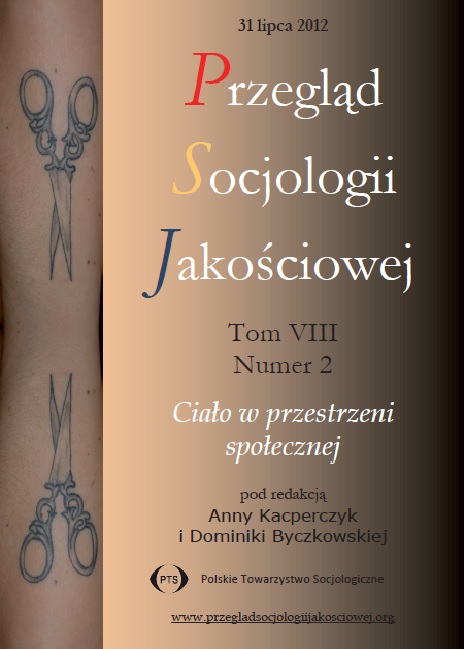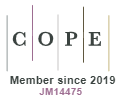Ciała osobliwe w przestrzeni "freak/talk show"
DOI:
https://doi.org/10.18778/1733-8069.8.2.10Słowa kluczowe:
dziwoląg, pokazy osobliwości, odmienność cielesna, reprezentacja inności, niepełnosprawnośćAbstrakt
Odmienność cielesna jest podstawą doświadczania obcości drugiego człowieka. Konfrontacje z ciałami osobliwymi w przestrzeni publicznej pozostawiają nas często bezradnymi, a jednocześnie wymagają wypracowania strategii radzenia sobie z ich obcością. W nowoczesności wykreślone zostały dwie główne ramy dla heterotopicznej cielesności: medykalizacja i normalizacja. Mogłoby się więc zdawać, że w miejscu dotychczasowej przestrzeni pokazów osobliwości zieje pustka. Ślady spektakularnej logiki freak shows da się jednak wytropić w telewizyjnym formacie talk show. Ich zestawienie w tekście nie ma na celu jedynie skonstatowania powierzchownych analogii, ale też wskazanie na głębsze podobieństwa w odniesieniu do reprezentacji cielesnej odmienności oraz poszukiwanie metanarracji usprawiedliwiającej jej obsceniczność. Artykuł zamyka pytanie o możliwość wykorzystania ambiwalencji pokazów osobliwości (jak w performansach niepełnosprawnych artystów) do uobecniania ciał osobliwych w przestrzeni publicznej.
Pobrania
Bibliografia
Bauman Zygmunt (2000) Ponowoczesność jako źródło cierpień. Warszawa: Wydawnictwo Sic!
Google Scholar
Bogdan Robert (1996) The Social Construction of Freaks [w:] Rosemarie Garland-Thomson, ed., Freakery. Cultural Spectacles of the Extraordinary Body. New York: New York University Press, s. 23–37.
Google Scholar
Dijck van José (2002) Medical documentary: conjoined twins as medical spectacle. „Media, Culture & Society”, vol 24, no. 4, s. 537–556.
Google Scholar
DOI: https://doi.org/10.1177/016344370202400405
Durbach Nadja (2010) Spectacles of Deformity. Freak Shows and Modern British Culture. Berkeley: University of California Press.
Google Scholar
DOI: https://doi.org/10.1525/9780520944893
Garland-Thomson Rosemarie, ed., (1996) Freakery. Cultural Spectacles of the Extraordinary Body. New York: New York University Press.
Google Scholar
Garland-Thomson Rosemarie, ed., (2009) Staring. How We Look. New York: Oxford University Press.
Google Scholar
Godzic Wiesław (2004) Telewizja i jej gatunki po „Wielkim Bracie”. Kraków: Wydawnictwo Universitas.
Google Scholar
Goffman Erving (2005) Piętno. Rozważania o zranionej tożsamości. Przełożyły Aleksandra Dzierżyńska, Joanna Tokarska-Bakir. Gdańsk: Gdańskie Wydawnictwo Psychologiczne.
Google Scholar
Hadley Bree (2008) Mobilizing the Monster: Modern Disabled Performers’ Manipulation of the Freakshow. „M/C Journal”, vol. 11, no. 3 [dostęp 7 czerwca 2010 r.]. Dostępny w Internecie http://journal.mediaculture.org.au/index.php/mcjournal/article/viewArticle/47
Google Scholar
DOI: https://doi.org/10.5204/mcj.47
Kuppers Petra (2004) Disability and Contemporary Performance: Bodies on Edge. New York: Routledge.
Google Scholar
McKenzie Jon (1995) Telepathy, the Elephant Man, Monstration. „Journal of Popular Culture”, vol. 28, no. 4, s. 19–36.
Google Scholar
DOI: https://doi.org/10.1111/j.0022-3840.1995.00019.x
Rozmowy w toku. Prowadząca Ewa Drzyzga. Wybrane odcinki programu emitowanego przez TVN w latach 2007–2008 [dostęp 5 czerwca 2010 r.]. Dostępne w Internecie http://rozmowywtoku.tvn.pl/odcinki.html
Google Scholar
Sandahl Carrie, Auslander Philip, eds., (2005) Bodies in commotion: disability and performance. Ann Arbor: The University of Michigan Press.
Google Scholar
DOI: https://doi.org/10.3998/mpub.92455
Snyder Sharon L., Mitchell David T. (2001) Re-engaging the Body: Disability Studies and the Resistance to Embodiment. „Public Culture”, vol. 13, no. 3, s. 367–389.
Google Scholar
DOI: https://doi.org/10.1215/08992363-13-3-367
Stulman Dennett Andrea (1996) The Dime Museum Freak Show Reconfigured as Talk Show [w:] Rosemarie Garland-Thomson, ed., Freakery. Cultural Spectacles of the Extraordinary Body. New York: New York University Press, s. 315–326.
Google Scholar
Wieczorkiewicz Anna (2006a) Powrót Człowieka-Słonia. O problemach z doświadczaniem obcości [w:] Ryszard Nycz, Anna Zeidler-Janiszewska, red., Nowoczesność jako doświadczenie. Kraków: Wydawnictwo Universitas, s. 135–164.
Google Scholar
Wieczorkiewicz Anna (2006b) Osobny świat osobliwości. „Kultura i Społeczeństwo”, nr 4, s. 3–30.
Google Scholar
Pobrania
Opublikowane
Jak cytować
Numer
Dział
Licencja

Utwór dostępny jest na licencji Creative Commons Uznanie autorstwa – Użycie niekomercyjne – Bez utworów zależnych 4.0 Międzynarodowe.














